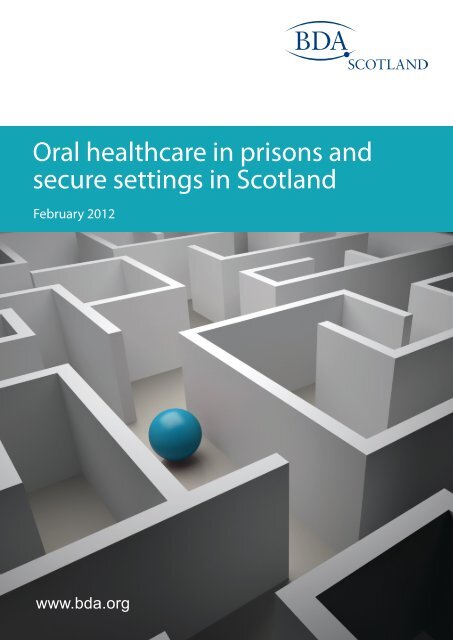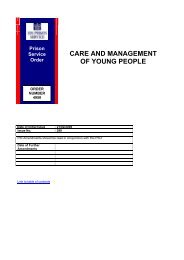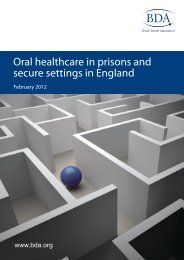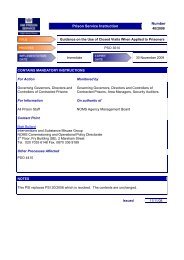Oral Health in Scottish Prisons - Inside Time
Oral Health in Scottish Prisons - Inside Time
Oral Health in Scottish Prisons - Inside Time
You also want an ePaper? Increase the reach of your titles
YUMPU automatically turns print PDFs into web optimized ePapers that Google loves.
<strong>Oral</strong> healthcare <strong>in</strong> prisons andsecure sett<strong>in</strong>gs <strong>in</strong> ScotlandFebruary 2012www.bda.org
Dentists and dental teams <strong>in</strong>volved <strong>in</strong> the treatment of prisonersand those <strong>in</strong> secure sett<strong>in</strong>gs must be supported to provide thelevels of care needed by their populations.What is the problem?Provid<strong>in</strong>g dental services <strong>in</strong> a prison environment presents dentists with many unique challenges,<strong>in</strong>clud<strong>in</strong>g concerns about threats to personal security, <strong>in</strong>ability to move freely, and the requirementsto deliver modern dental services <strong>in</strong> an environmentthat, <strong>in</strong> many cases, requires modernisation. Muchof what is taken for granted <strong>in</strong> high street practicesmay be difficult to implement, while on the otherhand practitioners f<strong>in</strong>d themselves bound by anadditional prison rule book. Ensur<strong>in</strong>g compliancewith decontam<strong>in</strong>ation and other cl<strong>in</strong>ical guidel<strong>in</strong>es <strong>in</strong> a prison environment with its strict securityprocedures, for example, represents an unusual, and not <strong>in</strong>significant, challenge.Why is it a problem?Prisoner profileSecure sett<strong>in</strong>gs are prisons,young offenders’ <strong>in</strong>stitutes andsecure psychiatric hospitals.<strong>Prisons</strong> <strong>in</strong> Scotland are runn<strong>in</strong>g at high capacity. Accord<strong>in</strong>g to the Auditor General for Scotland“prisoner numbers have <strong>in</strong>creased significantly s<strong>in</strong>ce 2000/01, with the highest ever number of7,700 recorded <strong>in</strong> April 2008. The number of prisoners is projected to <strong>in</strong>crease by almost 20 percent by 2016/17” (Audit Scotland 2008:05).Many prisoners suffer from mental health issuesor learn<strong>in</strong>g difficulties, a higher proportion than thegeneral population (Department of <strong>Health</strong> (England)2003:06). The prison population is a high needs yetvulnerable group with complex oral health needs whichcan be complicated by drug and alcohol addictionand dependence problems. In 2007, the World <strong>Health</strong>Organisation reported that “prisoners with substancemisuse problems are likely to report toothache verysoon after enter<strong>in</strong>g prison, as any opiate drugs they tooksuppressed the toothache” (2007:148). In support<strong>in</strong>gprisoners through drug and alcohol rehabilitationprogrammes, the dental team is well placed to be partof the multi-discipl<strong>in</strong>ary healthcare team.An age<strong>in</strong>g populationThe already complex needs of the prison population are exacerbated as prisoners enter old age.The prison environment has a significant impact on prisoners’ general health, mean<strong>in</strong>g thatprisoners may be 10-15 years olderphysiologically than those of the same ageoutside prison. In addition, older prisonerssuffer accelerated biological age<strong>in</strong>g, whichhas severe implications on oral as well asgeneral health (National Association ofPrison Dentistry UK 2010:1).In the last ten years, the number of sentencedprisoners over 60 <strong>in</strong> England and Wales hasgrown by almost 250 per cent” (Hayes &Shaw 2011:38). Heath and Iqbal report that“it is recognised that the prison populationis generally from marg<strong>in</strong>alised communitiesthat have poor access to primary healthcare”(2007:42). This comb<strong>in</strong>ation, of the age<strong>in</strong>g prisoner and poor access to healthcare <strong>in</strong> earlier lifebr<strong>in</strong>gs additional challenges to an already stretched prison healthcare system.Prison facilities and the provision of servicesI recently met a woman<strong>in</strong> Holloway who hadassaulted a member ofstaff and it turned out she had doneit deliberately to prolong her stayas she was mid-way through dentaltreatment and it was the first timeshe had been to a dentist.”Crook 2009:31The prison environment often presents additional barriers to the delivery of appropriate and effectivecare to an already high needs population.The prison population often present with high needs, as emergency and urgent cases, and accessor follow<strong>in</strong>g through with care as a prisoner isn’t always easy. The high turnover of prisoners <strong>in</strong>some <strong>in</strong>stitutions, particularly <strong>in</strong> remand or short-stay <strong>in</strong>stitutions, where short sentences or frequenttransfers between facilities mean courses of treatment can go unf<strong>in</strong>ished. When prisoners aretransferred between facilities, this has implications for the oral and general health of the patient, theworkload of the receiv<strong>in</strong>g dentist at theWhile treat<strong>in</strong>g this particularpopulation provides many<strong>in</strong>terest<strong>in</strong>g challenges,theproblems of provid<strong>in</strong>g efficienthealthcare with<strong>in</strong> the many restrictionsimposed by the prison system canmake it a frustrat<strong>in</strong>g experience.”Dr J Husband 2010next <strong>in</strong>stitution and the additional cost tothe NHS of commenc<strong>in</strong>g a new courseof treatment where dental records arenot transferred with the patient. On 12April 2011, the Department of <strong>Health</strong> <strong>in</strong>England issued a press release aboutthe improvements <strong>in</strong> prison health as aresult of a national IT system <strong>in</strong> prisonsand young offenders’ <strong>in</strong>stitutes. Theproject aims to improve cont<strong>in</strong>uity ofcare for prisoners mov<strong>in</strong>g betweenprisons because of the <strong>in</strong>stallation ofa new system conta<strong>in</strong><strong>in</strong>g up to date medical <strong>in</strong>formation, thus liberat<strong>in</strong>g cl<strong>in</strong>icians to concentrateon patient care. We hope that any advancements <strong>in</strong> IT <strong>in</strong> Scotland will mean improved transfer ofdental patient records, provid<strong>in</strong>g that the new technology can be <strong>in</strong>tegrated <strong>in</strong>to exist<strong>in</strong>g IT systems.
The transient nature of the prison population hampers cont<strong>in</strong>u<strong>in</strong>g dental care as well as provid<strong>in</strong>ga constant supply of new high needs patients. Given these issues, the challenge of provid<strong>in</strong>geffective dental care to prisoners is highlighted <strong>in</strong> the model shown by Harvey et al (2005:07).Demand• Demand<strong>in</strong>g consumers• Turnover of prison population• Difficulties <strong>in</strong> provid<strong>in</strong>gcont<strong>in</strong>uity of care• Interupted treatments andnon-attendanceChallenges to deliver<strong>in</strong>g careDentists and dental teams work<strong>in</strong>g <strong>in</strong> secure sett<strong>in</strong>gs are committed to provid<strong>in</strong>g this importantservice but are often not appropriately supported to deliver the care needed by their patients. TheNAPDUK guide to work<strong>in</strong>g <strong>in</strong> prisons suggests that “sometimes prison dentists and dental careprofessionals can face difficult dilemmas when exist<strong>in</strong>g prison regimes and safe cl<strong>in</strong>ical practicedo not co<strong>in</strong>cide and their ethical obligations as regulated professionals meant that they may haveto challenge traditional prison practices” (NAPDUK 2010:i). It is important the <strong>in</strong>creased regulationdoes not imp<strong>in</strong>ge on patient care particularly for the vulnerable patients found <strong>in</strong> prison andsecure sett<strong>in</strong>gs. It is also important that to ensure this, practitioners <strong>in</strong> such environments receiveadequate support to enable the high standards of <strong>in</strong>fection control and cl<strong>in</strong>ically safe environmentsare reta<strong>in</strong>ed but <strong>in</strong> a manner suitable to the prison environment.BDA survey resultsNeeds• High levels of need• Long stand<strong>in</strong>g neglect <strong>in</strong> oral health• Rout<strong>in</strong>e checks and health promotiongiven less priority due to high needs• Drug misuse and smok<strong>in</strong>g <strong>in</strong>creasedental health needs• NutritionhResourcesWait<strong>in</strong>g times• Availability of dental care products• Outdated facilities and equipment• Lack of spacehhh• Lack of fund<strong>in</strong>g for health promotionand additional sessions• Insufficient staff for treatment and for security• Staff tra<strong>in</strong><strong>in</strong>g and quality assuranceSupply• Shortages <strong>in</strong> dental time• Sessions shortened bysecurity procedures• Recruitment and retention• Quality of dental care• Availability of rout<strong>in</strong>etreatment <strong>in</strong> some prisons• Availability of oral healthpromotionHarvey et al (2005:07)In 2010, the BDA embarked on a project across the UK to gather evidence from prison dentistsregard<strong>in</strong>g the challenges of work<strong>in</strong>g <strong>in</strong> the prison environment. On average, over half of thosesurveyed had worked <strong>in</strong> prison dentistry for between six and 15 years, show<strong>in</strong>g a dedication totreat<strong>in</strong>g these vulnerable members of society (BDA 2010:12). The survey results highlighted that64 per cent of respondents said they would like to receive more tra<strong>in</strong><strong>in</strong>g particularly around securityor cl<strong>in</strong>ical tra<strong>in</strong><strong>in</strong>g on patients with substance abuse issues. The clear message from the surveywas that the delivery of dentistry with<strong>in</strong> the prison structure was <strong>in</strong> many ways different to highstreet dentistry and care was not as easily deliverable <strong>in</strong> secure sett<strong>in</strong>gs where <strong>in</strong>frastructure wassometimes built pre 1900, and where security (for obvious reasons) was <strong>in</strong>flexible.What is the solution?The BDA makes these recommendations to:• <strong>Scottish</strong> Government Justice Directorate• <strong>Scottish</strong> Government <strong>Health</strong> and Social Care Integration Directorates• Chief Dental Officer and Dentistry Division• NHS Boards• <strong>Scottish</strong> Prison Service• Dental Care Providers• NHS Education Scotland1. The <strong>Scottish</strong> Government <strong>Health</strong> and Social Care Integration Directorates and NHS Boardsshould ensure that prison dental healthcare services are suitably contracted to ensureappropriate dental care for all.2. The <strong>Scottish</strong> Government Justice Directorate, the <strong>Scottish</strong> Government <strong>Health</strong> and SocialCare Integration Directorates, NHS Boards, the <strong>Scottish</strong> Prison Service and dental careproviders should make clear the NHS offer and provide assistance to dentists if cl<strong>in</strong>icaldecisions are not understood or agreed with by the patient.3. NHS Boards and the <strong>Scottish</strong> Government <strong>Health</strong> and Social Care Integration Directoratesshould put <strong>in</strong> place an agreement on the appropriate wait<strong>in</strong>g time for <strong>in</strong>itial exam<strong>in</strong>ation,ongo<strong>in</strong>g rout<strong>in</strong>e care and access to emergency provision with an outl<strong>in</strong>e for measur<strong>in</strong>gthese times.4. The <strong>Scottish</strong> Government <strong>Health</strong> and Social Care Integration Directorates and the NHSBoards should develop an appropriate system for the transfer of patient oral health history <strong>in</strong> atimely manner when the patient is moved to ensure cont<strong>in</strong>u<strong>in</strong>g care to be availableto prisoners.5. NHS Boards should establish a basel<strong>in</strong>e of exist<strong>in</strong>g practices to ensure they are fit for purposeand appropriate resources should be allocated to correct deficiencies.6. The <strong>Scottish</strong> Government Justice Directorates and NHS Boards should ensure that thedental team is fully <strong>in</strong>tegrated <strong>in</strong>to the prison health team and ensure open channels ofcommunication.7. NHS Boards, the <strong>Scottish</strong> Prison Service and dental care providers should ensure that alldentists and dental care professionals new to the prison environment should receive a full<strong>in</strong>duction to prison security protocol and given an immediate <strong>in</strong>duction plan. Tra<strong>in</strong><strong>in</strong>g on thefollow<strong>in</strong>g should form a mandatory part of the <strong>in</strong>duction process:a. general securityb. personal protectionc. situation de-escalation
d. handl<strong>in</strong>g difficult prisonerse. understand<strong>in</strong>g the crim<strong>in</strong>al justice system8. NHS Boards and dental care providers should make all cl<strong>in</strong>icians new to prison dentistryaware of the National Association of Prison Dentistry UK handbook, Dentistry <strong>in</strong> <strong>Prisons</strong>,which gives comprehensive advice from peers.9. NHS Education Scotland should make available more prison-specific cl<strong>in</strong>ical tra<strong>in</strong><strong>in</strong>gs courseson issues <strong>in</strong>clud<strong>in</strong>ga. drug misuse and the impact on oral healthb. alcohol misuse and the impact on oral healthc. deal<strong>in</strong>g with alcoholismd. management of failed/fail<strong>in</strong>g dentitione. medical emergencies <strong>in</strong> the prison environmentf. deal<strong>in</strong>g with complex drug therapyg. treatment plann<strong>in</strong>g for the transient population10. NHS Boards should ensure that NHS contracts should be awarded <strong>in</strong> such a way that theyattract superannuationHow do decision-makers implement the solutions?Dentists and dental care professionals work<strong>in</strong>g <strong>in</strong> prisons, young offenders’ <strong>in</strong>stitutes and securepsychiatric hospitals should be supported to deliver the high quality care they want and need togive their patients. In Scotland, prison dentists are now accountable to two organisations: NHSBoards and the prison authorities. This has the potential to cause confusion for prison dentistsabout where responsibility for an issue may lie and the dentist be<strong>in</strong>g “stuck <strong>in</strong> the middle” (BDAsurvey 2010:9).The recommendations we make offer a way forward to ensure that practitioners provid<strong>in</strong>g care topatients <strong>in</strong> secure sett<strong>in</strong>gs are supported to deliver appropriate care.ReferencesAudit Scotland (2008) Manag<strong>in</strong>g <strong>in</strong>creas<strong>in</strong>g prisoner numbers <strong>in</strong> ScotlandAvailable: http://www.audit-scotland.gov.uk/docs/central/2008/nr_080508_prisoner_numbers.pdfBDA (2010) Prison dentist surveyAvailable: http://www.bda.org/Images/prison_dentist_survey_report_sept_2010.pdfCrook, F. (2009) “Everybody Hurts: The social costs of the failure of prisons”. Perrie Lectures.Prison Service Journal. Issue 186, p29-31.Department of <strong>Health</strong> (2003) Strategy for Modernis<strong>in</strong>g Dental Services for Prisoners <strong>in</strong> England.Available: http://www.dh.gov.uk/prod_consum_dh/groups/dh_digitalassets/@dh/@en/documents/digitalasset/dh_4068229.pdfDepartment of <strong>Health</strong> (2011) Press release: Prison health to improve as result of national ITsystem.Available: http://www.dh.gov.uk/en/MediaCentre/Pressreleases/DH_125986Harvey, S., Anderson, B., Cantore, S., K<strong>in</strong>g, E., Malik, F. (2005) “Reform<strong>in</strong>g prison dental services<strong>in</strong> England – a guide to good practice”.Available: http://www.dh.gov.uk/en/Publicationsandstatistics/PublicationsPublicationsPolicyAndGuidance/DH_4139050Hayes, A., Shaw, J. (2011) “Practice <strong>in</strong>to Policy: The Needs of Elderly Prisoners <strong>in</strong> England andWales”. Prison Service Journal. Issue 194, p38-44.Heath, L., Iqbal, Z. (2007) “Measur<strong>in</strong>g the health status of prisoners”. Prison Service Journal.Issue 174, p42-44.Available: http://www.hmprisonservice.gov.uk/resourcecentre/prisonservicejournal/<strong>in</strong>dex.asp?id=7534,3124,11,3148,0,0HM Prison Service – Population figures to April 2011Available: http://www.hmprisonservice.gov.uk/resourcecentre/publicationsdocuments/<strong>in</strong>dex.asp?cat=85M<strong>in</strong>istry of Justice – Population figures from April 2011Available: http://www.justice.gov.uk/publications/statistics-and-data/prisons-and-probation/prisonpopulation-figures/<strong>in</strong>dex.htmNational Association of Prison Dentistry UK (2010) “Dentistry <strong>in</strong> prisons: a guide to work<strong>in</strong>g with<strong>in</strong>the prison environment”. Stephen Hancocks Ltd, London.WHO (2007) “<strong>Health</strong> <strong>in</strong> prisons; A WHO guide to the essentials <strong>in</strong> prison health”. Eds Møller, L.,Stöver, H., Jürgens, R., Gatherer., A., Nikogosian, H.Available: http://www.euro.who.<strong>in</strong>t/__data/assets/pdf_file/0009/99018/E90174.pdf

















